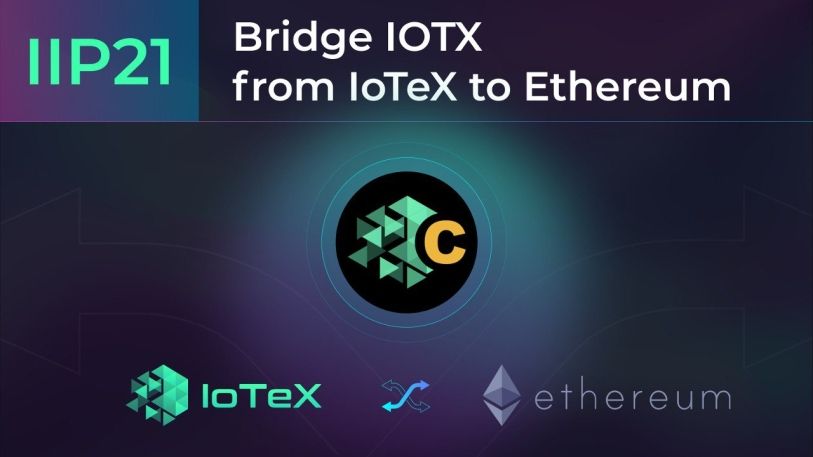
IIP-21: Why CIOTX on Ethereum is Beneficial
As recently announced, the IoTeX blockchain's governance community has voted to approve the IIP-21 to bridge the native IOTX from the IoTeX network to Ethereum and implement CIOTX (Cross-chain IOTX) token on Ethereum. This plan aims to improve our native token's utilization and demand in DeFi protocols on Ethereum and exchanges. The community participated quite extensively as 334 wallets registered to vote, representing 306 million staked IOTX with 73.77% voting in favor and the remaining 26.23
As recently announced, the IoTeX blockchain's governance community has voted to approve the IIP-21 to bridge the native IOTX from the IoTeX network to Ethereum and implement CIOTX (Cross-chain IOTX) token on Ethereum. This plan aims to improve our native token's utilization and demand in DeFi protocols on Ethereum and exchanges.
The community participated quite extensively as 334 wallets registered to vote, representing 306 million staked IOTX with 73.77% voting in favor and the remaining 26.23% against.
The vote reflects the community's enthusiasm for expanding the utility and reach of the IOTX token through cross-chain interoperability. And thus, today, we believe it's worth recapping why the CIOTX benefits the entire IoTeX ecosystem.
"One of the primary motivations behind IIP-21 is to leverage Ethereum's robust DeFi ecosystem, increase IoTeX token liquidity within Ethereum, and build a vibrant developer and user community," said IoTeX CEO and Co-Founder Raullen Chai. "The proposed bridge between IoTeX and Ethereum holds immense potential for both platforms and the broader blockchain community."
Another significant benefit that CIOTX brings is facilitating access for Ethereum users and developers, particularly ahead of the release of W3bstream Devnet, which supports Ethereum. W3bstream also supports Polygon and IoTeX, and support for other major blockchains is on the W3bstream roadmap.
Understanding CIOTX
IoTeX's ecosystem has witnessed the evolution of several token versions, including IOTX (native), IOTX-E (ERC20), which was first introduced in 2021, and CIOTX. These versions have crucial roles in enabling token transfers and liquidity across blockchains.
The IoTeX Foundation launched ioTube, a cross-chain bridge that enables tokens on IoTeX to be bridged to other blockchains (e.g., Ethereum, Polygon, Binance Chain) and vice versa. As part of this effort, a third type of IOTX token was introduced called CIOTX, or “cross-chain IOTX”, to standardize the name of any IOTX that was bridged to other blockchains.
IOTX-E and CIOTX are fundamentally different – most notably, the total supply of IOTX-E is capped while the total supply of CIOTX is dynamic.
A key CIOTX feature is that it allows for seamless token transfers and is a standardized representation of IOTX tokens on other chains. CIOTX ensures compatibility and facilitates participation in DeFi and DePIN (Decentralized Physical Infrastructure Networks) applications and other use cases beyond the IoTeX network.
Replacing IOTX-E with CIOTX
One potential approach the IoTeX core team is considering is working with exchanges to replace IOTX-E with CIOTX. This approach offers several benefits, including:
- Liquidity Enhancement: By replacing IOTX-E with CIOTX, tokens' supply and liquidity on exchanges that have listed IOTX-E will be equalized. This reduces exchange price discrepancies and fosters a more consistent user trading experience.
- Improved User Experience: Reducing the number of deposit/withdrawal and cross-chain conversion errors associated with managing multiple token versions simplifies the user experience, particularly for newcomers to the Web3 ecosystem.
- Native IoTeX Benefits: Exchanges supporting CIOTX or native IOTX provide users access to additional benefits specific to the IoTeX network. This includes opportunities for staking and participation in governance activities, offering users more comprehensive engagement possibilities.
Implementation Challenges
Replacing IOTX-E with CIOTX involves coordination with exchanges, Layer 1 blockchains, and other entities currently utilizing IOTX-E. The adoption of native IOTX or CIOTX by exchanges remains a collaborative effort. That said, we've considered several alternatives:
- Working with Exchanges for Native IOTX: Collaborating with exchanges to support native IOTX would be preferred. This requires a case-by-case assessment of exchanges' interest and capacity to integrate native IOTX.
- Replacing IOTX-E with CIOTX: Working with major exchanges that have listed IOTX-E to swap IOTX-E deposits with CIOTX deposits presents an alternative solution. This approach also depends on the exchanges' willingness and capacity to facilitate the transition.
- Increasing the Supply of IOTX-E: Exploring the possibility of unfreezing the IOTX-E token smart contracts on Ethereum to increase its supply has been considered. However, execution risks associated with this approach may limit its viability.
Seamless token swapping
Swapping is important as well. By Introducing CIOTX on Ethereum, seamless swapping of tokens between CIOTX and IOTX-E can take place. By listing CIOTX alongside IOTX-E on decentralized exchanges like Uniswap and Curve, users can exchange the two tokens at market prices, with the market determining their respective values based on demand. This feature enhances liquidity and provides greater flexibility for users in managing their IOTX assets.
And of course, the benefits of blockchain bridges extend beyond IoTeX and Ethereum. With IoTeX diverting some network traffic from Ethereum, the bridge helps alleviate the congestion and scalability challenges the Ethereum network faces. By dispersing transactions to other less congested blockchains, bridges contribute to the overall improvement of blockchain scalability and user experience.
Leveraging IoTeX's efficiency
With the bridging of IOTX to Ethereum, businesses can now explore the possibility of enabling instant payments using IOTX or CIOTX tokens, leveraging the speed and efficiency of the IoTeX network while benefiting from Ethereum's vast user base and DeFi infrastructure.
The successful implementation of IIP-21 and bridging IOTX to Ethereum represent a significant milestone for IoTeX and the entire blockchain industry. As blockchain bridges continue to gain prominence, we expect to witness the emergence of new use cases and innovative applications across various sectors, ultimately driving the widespread adoption of blockchain technology and fostering a more interconnected and efficient decentralized ecosystem.
Subscribe
Subscribe to get the latest posts from IoTeX Blogs delivered to your inbox.